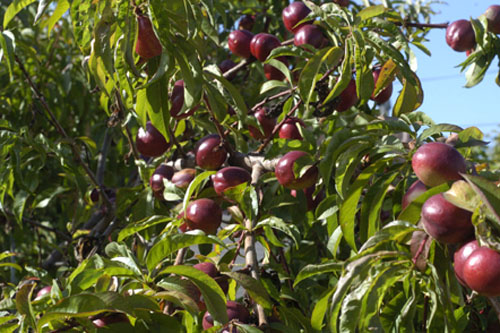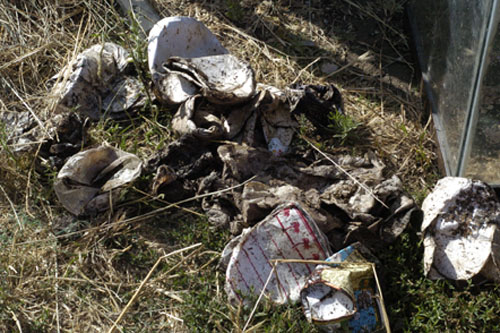Garden Report: July 23
So, summer's in full swing and while there is a lot of stuff going on, none of it is, alas, bloggable.
So let's talk about plants.
This is my variegated willow. It's finally gotten to "oversized bush" size this summer, which is a step up from "dying twig." It's going to end up as a smallish tree. I planted this right where the neighbor's downspout (technically illegally) empties onto our side lawn, so it gets lots of water when there's water. Its primary job is keeping the side yard from bogging down, and it seems to do that very well. The neighbor also thinks it's beautiful, which is a highly desirable situation, since it is very close to her house, and is sited to block views from her house into ours.

Anyway, at this point the central leader on the willow has gotten all kinds of willowy and floppy (see it leaning off to the left below? OK, maybe not so obvious to somebody who doesn't look at the tree every day), and I need to stake it. It's incredibly difficult to find a source of looooong stakes for this situation. I gave it a lot of thought and finally decided to just tie it into place, though that will mean a lot more stakes. I'd hoped to find one, single straight stake to drive into the ground next to it and tie the leader to. No deal.

Speaking of unsupported plants, my worries for our yet-unsupported passiflora vine have proved unfounded. It has been blooming like mad, and I suspect there will be a lot of passionfruit this fall. Maybe I will get to try out that fancy passionfruit jam recipe. Or maybe we will just eat them all with a spoon right off the vine.

That mystery flower from my last report has turned out to be, yes, a coreopsis. I don't recall planting one that looks like this, but I'm kind of absent-minded about the garden this year, so it's definitely possible. It's very pretty.

This week I did the unpleasant deed and cut the heck out of my poor quince to get rid of the fireblight. I actually left one blighted branch on because it has a lot of fruit on it, and I was going to prune it off this fall, anyway, blah blah blah. But look: the poor thing lost three feet of height. It looks like a stick. You can hardly see it behind the apples there, and they're on dwarfing rootstock. Ugh.

Speaking of apples, guess what this is? Our one and only Cox's Orange Pippin. The apple all our UK-ian friends told us to plant. It's going up against both White Winter Pearmain and Spitzenberg this fall in the Most Popular Apple in the Garden Contest, assuming the dogs don't steal it.

Speaking of dogs, and how they seem to think the whole garden belongs to them, here we have Rosie, checking the nectarines out. What is she looking at?

Why, just the next treeful of nectarines, ripening quickly. She should enjoy the low-hanging fruit while she can, because after this tree is done, I'm cutting off that lower limb, and picking fruit is going to be a lot harder for dogs.

In the dog-free garden, things are going OK. I really messed up the tomatoes this year, starting them late then nearly killing them all. But it turns out that several of the apparently dead tomatoes are actually alive. Like this one:

And we got our first Sungold cherry tomato today. I ate it. That's what Noel gets for staying late at work.

This has been my project of the week this week: outside the fence, a little circular strawberry garden. I've got some alpine strawberry plants to put in here, protected from dogs (who, admittedly, don't eat the strawberries as much as they just sort of lie on them) and chickens (who do eat the strawberries).

I'm going to find a tallish flower to put in the middle there.
I half-filled the new bed with fresh compost from the tumbling composter. The last year with that composter has taught me a couple of things that are crucial to getting it to produce compost for you in good time and without too much suffering.
1. Put stuff in in batches. Not only does this give you a definite start date for composting, and keep you from having endlessly unfinished compost, but it also keeps you from overfilling the composter. You fill it up, and the stuff breaks down and doesn't make it impossible to turn. We store stuff for the next batch in a plastic bin in the shed.
2. Add water regularly, especially in summer. Otherwise it tends to dry out.
3. Don't put in non-compostables. Which includes paper take-out containers. Alameda passed a no-styrofoam law last year, so now all our take-out containers are paper. Paper that is apparently lined with plastic. I guess I should have figured that one out, but I didn't, with predictable results. Here's what I sorted out of the finished compost:

Well, live and learn.
Technorati Tags: alameda, apples, compost, dogs, flowers, fruit, gardening, nectarines, passionfruit, pruning, quince, strawberries, tomatoes, trees, urban farming, vegetables
posted by ayse on 07/23/09